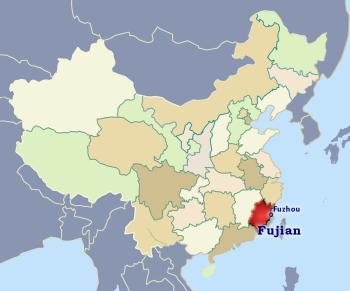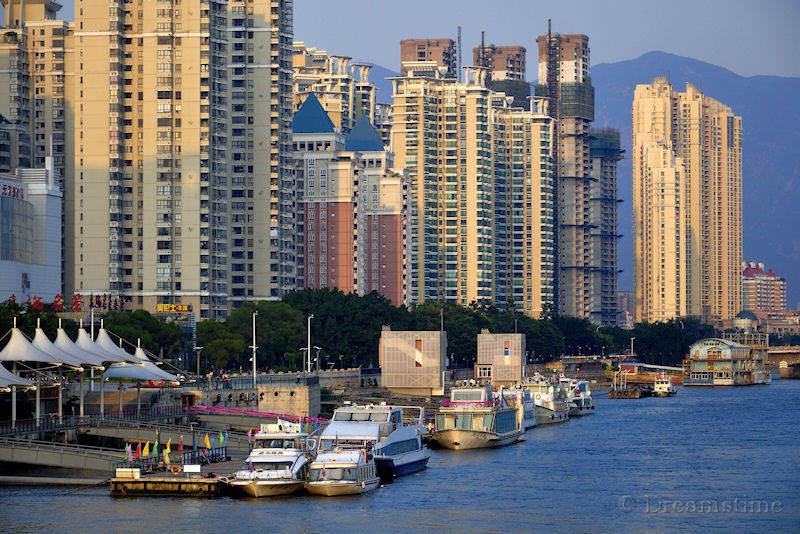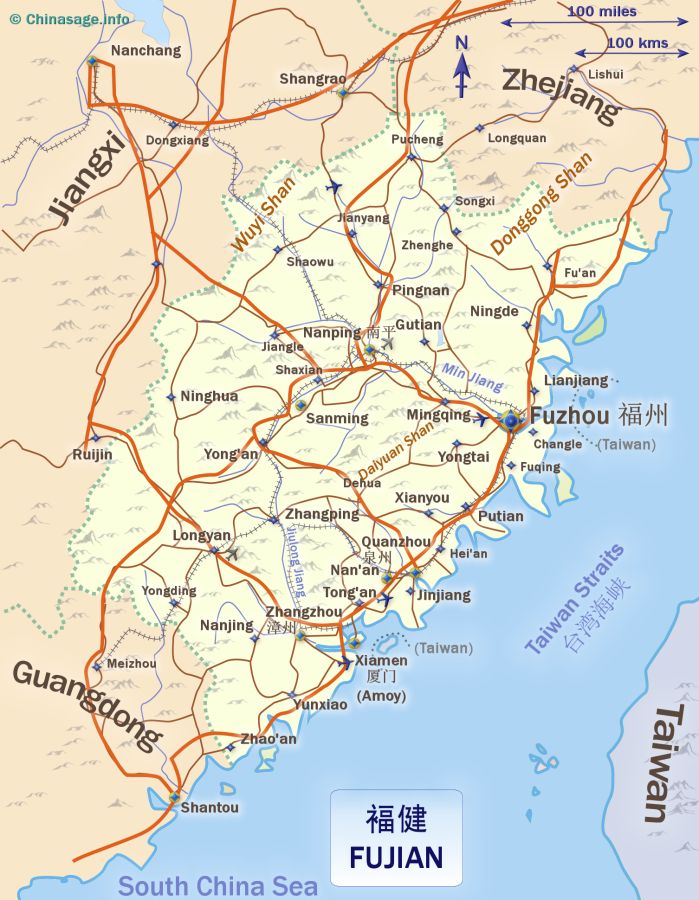Fujian, China

| Province | Fú jiàn 福健 'good fortune healthy' |
| Short name | 闽 Mǐn |
| Capital | Fuzhou |
| Population | 41.54 million (2.94%) [15th] comparison table |
| Area | 122,000 km2 [47,104 mile2] (1.27%) [23rd] |
| GDP | 105,690 (17.55%) [6th] |
| Neighbors | Guangdong Jiangxi Zhejiang |
| Others | or just click on the map |

Fujian is a mountainous province that looks primarily out to the Taiwan Straits and East China Sea and as such it has a certain feeling of independence from China. It is best known for the scattering of old attractive ports and islands along the rugged coastline. Indeed it remained the semi-independent kingdom of Min yue ➚ (闽蛮) for the period 330 to 110 BCE before it was conquered and assimilated by Han Emperor Wudi. The inhabitants are still sometimes referred to as the Min people. In the last days of the Song dynasty (1276-1279) Fujian was the last refuge from the conquering Mongols. It resisted the Qing conquest in 1644 the longest of all the provinces due to the efforts of Ming loyalist General Zheng Chenggong ➚ ( Guoxingye 国姓爷 Koxinga WG) who grew up near Quanzhou and used Xiamen as his base. Later in 1660 a Japanese invasion of 6,000 pirates and looters ransacked the province.

Xiamen
Xiamen (厦门) is an ancient trading port with historical links to the Portuguese, Spanish and Dutch. After the Opium Wars Xiamen came under the control of the British for fifty years. Better known as Amoy following the local dialect, the port and island of Gulangyu faces the island of Taiwan. There are many picturesque islands dotted around Xiamen. Nanputuo Temple ➚ is a famous Buddhist site. Gulangyu island was developed by Britain together with other foreign powers as an enclave, it has long been associated with egrets ➚ and attractive gardens. The Garden of the Countless Rocks (Wanshi Gongyuan) is close by and has pretty landscaped parks and temples. The Lu Xun Memorial Hall is a more modern attraction, commemorating the noted revolutionary writer who lived here in 1926. Lin Zexu ➚ the famous Commissioner who was tasked with stopping the import of British opium was born in Fujian. There is also an Overseas Chinese Museum here documenting the lives of the many who emigrated to foreign lands.


Quanzhou
The port of Quanzhou (泉州) was once more important than Xiamen, and was visited by Marco Polo and many other foreigners. Quanzhou, formerly known as Zayton or Chinchew, developed during the Tang dynasty as sea trading began to replace overland transport over the Silk Road to become one of China's four main ports. A sunken ship from the 12th/13th century was discovered in the bay in 1974 and is now exhibited in a museum there. The streets were lined with coral bean trees ➚ and it was known as the ‘Coral Bean City’ by foreign traders. Kaiyuan Temple ➚ is an amazing example of Tang dynasty architecture with one hundred stone pillars, it was originally named the Lotus Flower Temple. Here, a 900 year old stone bridge crosses the Luoyang River. It has seven pavilions and nine pagodas on either side. Confirming the dominant role of muslims in early sea trade, there is a cemetery at Lingshan dedicated to foreign traders and there is Qingjing mosque dating back to 1010. It was from here that muslim admiral Zheng He set out on his impressive voyages of discovery.

Other places in Fujian
By contrast the capital of Fujian Fuzhou (福州) has the feel of a modern industrial city, but it was a busy port all the way back in the Tang dynasty. There is the Hualin Temple which is of Tang date. Mount Gushan ➚ to the East has a famous Buddhist Yongquan (Boiling spring) temple of similar date. It became a treaty port under foreign control in late Qing times.
Not far away up the estuary from Xiamen is the ancient city of Zhangzhou, it is sited on the Jiulongjiang (nine dragon river) it boasts many temples including the Southern Mountain Temple ➚ and the Precious Hall of the Great Hero ➚.
Meizhou Island has many temples dedicated to the Goddess of the Sea Mazu who was very important to all the many seafarers of the province.

Inland near Yongding the ancient Tulou ➚ houses of the Hakka people can be seen at Fengsheng, Gaobei, Tianluokeng, Hongkeng and Chuxi. These strange circular multi-story buildings house a whole community and are set amidst the tea growing areas of the mountains. Tea is Fujian's most famous and important crop (particularly Oolong tea ➚ and Lapsang Souchong). Indeed the English word 'tea' comes from the local dialect word for tea 'ti' rather than Mandarin 'cha'. The moist air that often hangs over the mountains makes Fujian an ideal location for cultivating the tea bushes. The picturesque mountains of Wuyi, Tailao, Nanji, Zhiti, Dongyan and Magu are worth a visit and many of these have Buddhist and/or Daoist temples on them. The high mountains still harbor a few, rare tigers. Jinhu Lake ➚ is widely appreciated for its scenic beauty.

Fishing is a major industry in Fujian. The rocky coastline includes many islands and sandy beaches including those near Xiamen, Pingtan and Putian. In scattered towns there are remnants of old folk traditions such as Quanzhou puppetry and a local, distinctive Opera tradition. Handicrafts in lacquer-work, bamboo and shells are available widely.
Fujian history
Many of the Chinese diaspora originate from Fujian, some settled on the nearby island of Taiwan which was administered as part of Fujian province in Qing times. With only very poor roads over the mountains, the sea ports of Fujian were used by emigrants to sail away to a new life (and many as ‘coolies’). Hakka people live in the south west of the province and still use their own language.
More recently the defeat of Chiang Kaishek and the Republic of China Nationalists in 1949 led to continuing friction between Taiwan and the Communist mainland. There are isolated small islands (Jinmen and Mazu islands) within easy sight of the Fujian coast which ‘belong’ to the Taiwan government rather than Fujian and bristle with military defenses. The large, scattered diaspora of Fujianese in Taiwan and throughout south-east Asia has helped their families financially and funded industrial development and universities, as the emigrants still remember their ancestral roots and send money home. Continuing improvement of relations with Taiwan is bringing new opportunities for development.
Fujian Geography
Fujian has a rocky coastline and a mountainous hinterland. Fishing is the main coastal industry while inland it is forestry and tea cultivation. It has warm frost-free winters and hot summers, but is subject to damaging floods when typhoons move inland from the East China Sea in late summer.

Airports
The airport has 1 terminal and is located 34.2 miles (55.0 kms) from Fuzhou. Live Flight information ➚, rank in China 27
See map of location Fuzhou Changle International Airport
The airport has 1 terminal and is located 7.5 miles (12.0 kms) from Quanzhou. Live Flight information ➚, Airport information ➚, rank in China 49
See map of location Quanzhou Jinjiang Airport
The airport has 1 terminal and is located 4.3 miles (7.0 kms) from Wuyishan. Live Flight information ➚, Airport information ➚, rank in China 101
See map of location Wuyishan Airport
The airport has 4 terminals and is located 5.0 miles (8.0 kms) from Xiamen. Live Flight information ➚, rank in China 12
International Links to :Philippines Singapore Japan
See map of location Xiamen Gaoqi International Airport
Universities
Xiamen University 厦门大学
The university founded in 1921 was the first to be founded by overseas Chinese as Amoy University. It is ranked within the top 20 universities in China. Lu Xun is the most famous figure associated with the University.. Undergraduates: 17847, Postgraduates: 10286, International students: 2800, GP World ranking 406
Google map of Fujian
Bing map of Fujian ➚
Show Bing Map ➚
Fujian Climate

| Major Cities | Population | |
|---|---|---|
| Fuzhou | 福州 | 4,094,491 |
| Longyan | 龙岩 | 703,524 |
| Nan'an | 南安 | 1,500,000 |
| Nanping | 南平 | 491,287 |
| Ningde | 宁德 | 343,262 |
| Putian | 莆田 | 2,003,000 |
| Quanzhou | 泉州 | 184,143 |
| Sanming | 三明 | 379,701 |
| Xiamen | 厦门 | 5,163,970 |
| Zhangzhou | 漳州 | 589,831 |
Book: 60 Scenic Wonders in China: New World Press: 1980 pp. 107-113
Book: A Map History of Modern China: Catchpole: Heinemann: 1976 p. 22
Book: China : Eyewitness Travel: Dorling Kindersley: 2012 pp. 284-293
Book: Chronicles of the Chinese Emperors: Ann Paludan: Thames and Hudson: 1998 pp. 27-39
Book: Insight Guides: China: APA publications: 1994 pp. 279-285
Book: Lonely Planet: China: 1988 pp. 53-55, 296-304
Book: Modern China: A companion to a rising power: Graham Hutchings:… pp. 150-152
Book: Nagel's Encyclopedia guide: China: Nagel: 1978 pp. 1154-1164
Book: Symbols of China: Feng Jicai: Compendium: 2010 pp. 92, 129
Web page: Fujian ➚
Web page: Fujian (chinafolio) ➚
Web page: Fujian (wikipedia) ➚
Web page: Fujian (wikipedia) ➚
Web page: Fujian (wikitravel) ➚
Web page: Fujian Guide - Beautiful Coast And Hakka Culture ➚
Web page: Fujian Travel Guide: Map: Weather: Scenic Area: Tea ➚
Web page: Map of Fujian Province ➚
City populations for 2012, Province statistics National Bureau of Statistics 2014